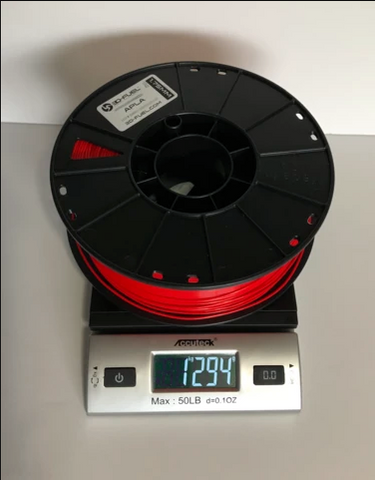Orders over $75 ship free in the United States (lower 48).
Orders over $75 ship free in the United States (lower 48).

Measure Twice - Print Once
As you casually walk over to check on your 3D print while it’s in process, you suddenly shudder and see that it is NOT working as you wanted it to. In fact, it has either stopped or is “Printing Air” as you see the print far below the nozzle and nothing in between them. What happened? How could this be?
There are many reasons 3D prints fail. One of the main reasons is basically due to poor planning on making sure you have enough filament on your spool before you begin. But the good news is that you can avoid this happening to you!
When you get a new spool of filament, it should have a standard amount of filament on it, usually measured in grams or kilograms. That means the spool should weigh that set amount plus a value equal to the weight of the spool itself. So, when you open your spool, weigh it to find out the total weight.

Here, we see that this full spool weighs 1.294kg or 1294g.
Next, subtract the weight of the filament from the package information. This is usually 1kg, 750g or 500g of material. The result is the weight of the spool. Use a label or a piece of masking tape on the side of the spool to mark that weight so you’ll know it moving forward. Now, you can weigh the spool anytime and subtract that number from it to see how many grams of filament are left on the spool. In the example above, the spool should weigh 294g, or 1294 minus 1000 since it is a 1kg spool.

This spool is nearing empty. It has just a couple of layers of filament left. But how much is that?
Using our math from above, the spool should weigh 294g. So, the current weight (446g) less the spool weight (294g) equals 152g of filament left.
Most slicers will allow you to preview the print and most will tell you the expected number of grams that you’ll need to produce the print. Just make sure that your spool has enough left on it for that amount and a little more, just in case. If you need 120g to print your object, and your spool only has 98g left on it, either go to another spool or make sure you’re using a runout sensor. It is possible to switch out spools on the fly, but you have to be right there and be pretty fast! In our case, we are pretty confident that the remaining filament on this spool is enough to print our 120g item.
By the way, once you’ve measured the spool weights you can start a chart of the brand filament, the type of filament and the weight of the spool. A lot of companies, like 3D-Fuel, use the same spool for all their 500g and 1kg products, so all you need to know is that one weight for most of your spools. Then, just refer to your spreadsheet or chart when you need to weigh one to make sure you have enough filament for your print.
And while we’re talking about handling your filament, always make sure to take care when changing filament that you don’t let the filament “run wild” while you handle it. Getting a turn of filament crossed over the loose end is a good way to ruin a print, too! It will eventually get caught and refuse to move, bringing the filament movement to a complete halt. Always hold the end tightly against the spool and when you remove it, put it in one of the holes along the side to keep it from getting under another turn of filament.
{"one"=>"Select 2 or 3 items to compare", "other"=>"{{ count }} of 3 items selected"}
Leave a comment